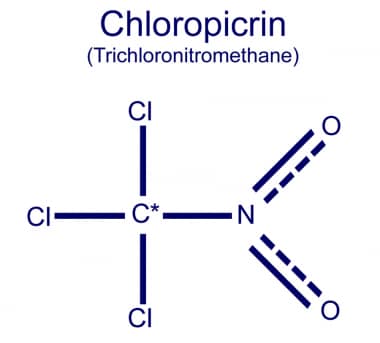Practice Essentials
Chloropicrin is a soil fumigant used for its broad biocidal and fungicidal properties, primarily in high-value crops such as strawberries, peppers, onions, tobacco, flowers, tomatoes, and nursery crops. [1] John Stenhouse, a Scottish chemist and inventor, synthesized chloropicrin in 1848. Because chloropicrin is toxic by all routes of entry, it has the potential for widespread destruction as a chemical warfare agent.
For patient education information, see Chemical Burns, Chemical Warfare and Personal Protective Equipment.
Properties, stability, and reactivity
Chloropicrin is a colorless–to–light green oily liquid with an intense and penetrating odor. Even though chloropicrin is not flammable, it poses a significant explosion hazard if involved in a fire. Bulk containers of this liquid are shock sensitive and can detonate. Chloropicrin is an irritant to all body surfaces. This liquid decomposes in the environment. Photochemical reactions with chloropicrin produce phosgene; other decomposition products include nitrogen oxides and chlorine compounds.
Chloropicrin photodegrades, with a half-life of 20 days. It is known to undergo violent reactions with aniline, 3-bromopropyne, sodium hydroxide/alcohol solutions, sodium methoxide, and propargyl bromide. Hazardous polymerization does not occur with chloropicrin. The chemical structure of chloropicrin is portrayed in the image below.
Detection
The odor is a distinctive warning property of this liquid compound.
Table. Symptoms According to Concentrations (Open Table in a new window)
1 ppm* |
Irritation with pain in the eyes |
4 ppm |
Incapacitates exposed individuals |
20 ppm |
Causes definite bronchial or pulmonary lesions |
*Concentrations expressed in parts of material per million parts of air or water. |
|
Pathophysiology
Inhalation
Overexposure leads to irritation of the nose and throat. Chloropicrin is a lacrimator. Exposure to vapors leads to coughing, labored breathing, sore throat, dizziness, bluish skin, vomiting, and in some instances, chemical pneumonitis and pulmonary edema. [2]
Contact with skin or eyes
Contact with chloropicrin can lead to chemical burns or dermatitis manifested by red, cracked, irritated skin. The extent of skin injury depends on the concentration and duration of exposure. Contact with the eyes can cause pain, redness, and tearing. Prolonged eye exposure to chloropicrin can cause blindness. Entrance through damaged skin causes similar symptoms as those seen in overexposure through inhalation.
Ingestion
If ingested, chloropicrin can cause burns to the mouth, throat, and esophagus. Other symptoms are similar to those of overexposure through inhalation. Ingestion of large quantities of chloropicrin liquid can be fatal.
Injection
Overexposure to chloropicrin by injection can lead to redness and irritation of surrounding tissues. Other symptoms are similar to those of overexposure through inhalation.
Chronic exposure
Dermatitis may result from repeated exposure to chloropicrin.
Epidemiology
Chloropicrin is commonly used as a soil fumigant for agricultural pest control. [3] Human exposures have occurred in the United States, usually in residential areas in close proximity to agricultural areas.
The most recently reported large-scale exposure occurred in Kern County, California, in 2003. [4] One hundred sixty-five people developed symptoms as a result of off-site drift of chloropicrin from a nearby agricultural site. Peak concentrations of chloropicrin were estimated to exceed 1 part per million.
Prognosis
Fatal chloropicrin exposures have been reported. An intentional ingestion of 100 mL of chloropicrin sodium solution resulted in death from metabolic acidosis and acute heart failure approximately 7 hours after ingestion. [5] Homicidal intoxication has also been reported, in which an 18-year-old female died approximately 4 hours after being sprayed with a liquid that was later determined to be chloropicrin. Postmortem examination demonstrated severe pulmonary edema. [6]
Elevations of creatine phosphokinase levels have been described in the setting of chloropicrin exposure and may represent some degree of rhabdomyolysis. [7] Chloropicrin may cause methemoglobinemia. [8]
-
Chemical structure of chloropicrin.
-
Level A suit (DuPont Tychem 10,000).










